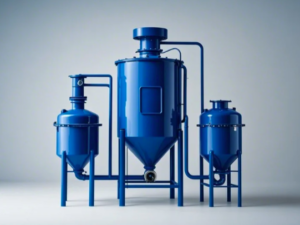RECENT POSTS
Share:
- December 17, 2024
Table of Contents
Mixing tanks are essential components in various industries, serving as vessels where ingredients are combined to create homogenous mixtures. They are crucial in industries such as pharmaceuticals, food and beverage, chemicals, and cosmetics, where precise mixing of components is necessary to ensure product quality and consistency. The core functions of mixing tanks include blending liquids, suspending solids, dispersing gases, and promoting heat transfer.

Types of Mixing Tanks
When it comes to selecting a mixing tank, understanding the different types available is key. Here’s a comparative list of common types based on their designs and materials:
– Stainless Steel Mixing Tanks: Known for their durability, corrosion resistance, and ease of cleaning, these are widely used in food and pharmaceutical industries. They are ideal for applications requiring high hygiene standards.
– Plastic Mixing Tanks: These are lightweight, cost-effective, and resistant to certain chemicals. They are suitable for less aggressive mixing processes and are often used in the cosmetic and chemical industries.
– Glass-Lined Mixing Tanks: These tanks are designed to handle highly corrosive materials, making them perfect for chemical processes. The glass lining provides a smooth surface that prevents contamination and facilitates cleaning.
Additionally, mixing tanks can vary based on their specific applications:
– Batch Mixing Tanks: Ideal for processes where ingredients are added and mixed in a single batch before being emptied.
– Continuous Mixing Tanks: Used in processes where ingredients are continuously fed into the tank and mixed without interruption.
Choosing the Right Mixing Tank
Selecting the appropriate mixing tank involves considering several critical factors:
– Capacity: The size of the mixing tank must match the production scale. Overloading a tank can lead to inefficient mixing and product inconsistency.
– Material: The choice of material (stainless steel, plastic, glass-lined) should be based on the nature of the substances being mixed. Compatibility with the ingredients is crucial to avoid contamination and ensure the longevity of the tank.
– Agitation System: The type of agitator (propellers, turbines, paddles) should match the mixing requirements. Factors such as viscosity, density, and the desired level of homogenization play a role in this decision.
– Industry-Specific Requirements: Different industries have unique needs. For example, pharmaceutical mixing tanks must comply with stringent regulatory standards, while food mixing tanks require easy-to-clean surfaces to maintain hygiene.
– Maintenance and Operational Efficiency: Consider the ease of maintenance and the overall operational efficiency of the tank. Tanks that are easy to clean and maintain reduce downtime and improve productivity.
Comparing different mixing tanks can further clarify the best choice:
– Stainless Steel vs. Plastic: Stainless steel tanks offer superior durability and hygiene, while plastic tanks are more cost-effective but may not be as durable.
– Batch vs. Continuous Mixing: Batch mixing is more suitable for small-scale, precise operations, while continuous mixing is ideal for large-scale, uninterrupted processes.
Conclusion and Future Trends
To summarize, mixing tanks are vital for producing homogenous mixtures in various industries. Choosing the right mixing tank depends on factors such as capacity, material, and the type of agitation system. It’s also important to consider industry-specific requirements and operational efficiency.
Looking ahead, advancements in mixing tank technology are promising. Emerging trends include the development of smart mixing tanks equipped with sensors and automation features, which can optimize the mixing process and enhance efficiency. Additionally, there is a growing focus on eco-friendly materials and designs that reduce environmental impact.
In conclusion, understanding the different types of mixing tanks and the criteria for selecting the right one is essential for ensuring effective and efficient mixing processes. By keeping abreast of future trends, industries can continue to improve their mixing operations and achieve better results.
0


